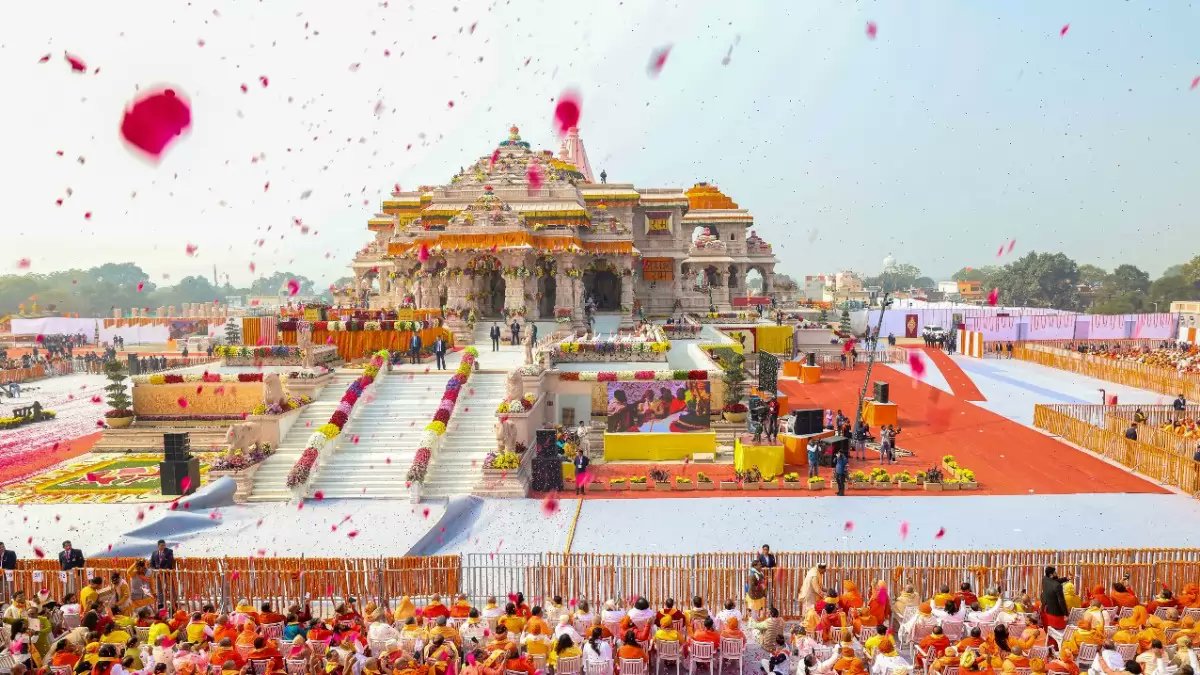Hindu communities around the world rejoiced at the consecration of the Shri Ram Mandir in Ayodhya, India, on January 22nd. Across the United States, many public events were held to mark this joyous occasion.
However, amidst the celebrations by Hindu Americans, several media outlets published misleading and factually incorrect reports about the Ram Mandir. It’s crucial to expose the false and biased claims in these reports.
Watch for a crisp analysis of misleading international media coverage
In which @PoojaShali shreds foreign media coverage of Shri Ram Janmsthan Mandir consecration on 22 January 2024.
Do watch. Ms Shali is one among the increasingly rare journalists who bluntly call a spade, a spade.
— Kanchan Gupta
(@KanchanGupta) January 24, 2024
The press in the United States is always cited as the beacon of hope because of its unbiased reporting and fearless publication of truth. However, the great beacon of hope has turned into a one-sided, biased, and lies-filled spewing of venom on the victims and calling for justice for the perpetrators.
For 500 long years, Hindus have held their breath with patient hope, enduring over two centuries of legal battles. Only after India’s Supreme Court delivered a definitive verdict in the title suit case, entrusting the disputed land to a government-appointed trust for the construction of the mandir, could this magnificent Ram Mandir finally rise. With the unanimous backing of the highest court, the site where this majestic temple stands now holds no trace of dispute whatsoever.
Some media reports say the Ram Mandir was built after destroying a mosque. But they ignore evidence of a large, pre-existing Hindu temple. Extensive excavations and studies, verified by the Supreme Court, confirm a temple stood there before being demolished in 1528 by Islamic invader Babur. The invaders not only destroyed the temple but also used the pillars and other uniquely Hindu iconographies to build the mosque.
The Supreme Court of India took note of the Hindu temple’s pillars and other iconography into accounts along with historical eyewitness records in reaching its decision. Archaeological findings conclusively show the Babri Mosque was built on top of this ancient temple. K.K. Muhammed, the key member of the Archeological Survey of India’s detailed site survey team, provides specific details about these discoveries.
Many reports highlight that Muslims worshipped at the mosque for centuries. The Supreme Court of India in its final verdict concluded that “namaz was not offered continuously in the inner section before 1857. In contrast, evidence points to continuous worship by the Hindus.”
The story of Ram Mandir finds echoes in many places all over the world. Take Istanbul’s Hagia Sophia, for example. Originally built in 537 as an Orthodox church, it saw its purpose shift throughout history. When the Ottomans conquered the city with their Muslim forces, it became a mosque. Then, after the Ottoman Empire’s fall in 1934, it was turned into a museum. Fast forward to July 2020, and a Turkish court reversed that, paving the way for President Erdogan to declare it a mosque once more.
Efforts to rebuild the Ram Mandir have persisted for centuries since the original temple’s destruction. The Ram Janmabhoomi movement gained significant momentum in the 1980s and early 1990s, with millions of Hindus contributing to the construction and pledging unwavering support.
Some reports claim 2000 people, mostly Muslims, were killed in 1992 following the demolition of the disputed structure. While this event was undeniably tragic, blaming any specific community is an oversimplification of a complex situation. Sectarian clashes have happened throughout history and in many parts of the world for various reasons and involving various communities. The 1992 occurrence saw casualties from all communities. Articles sensationalizing the claim that “only Muslims” were killed lack factual basis.
Bhagwan Ram, the seventh avatar of Bhagwan Vishnu, epitomizes the highest human ideals in various roles and responsibilities. Beyond geographical boundaries, language, or local traditions, Bhagwan Ram and the Ramayan are integral to Indian civilization and its culture. Ayodhya holds immense importance for Hindus worldwide as the birthplace of Bhagwan Ram.
Ayodhya is most prominent among the Sapta-Puri, the 7 most revered Hindu pilgrimage sites. In the light of Ayodhya, Hindus find not just a temple but a profound reminder of their cultural identity, a call to embody the virtues of Lord Ram, and a source of inner strength to navigate the world with grace, wisdom, and unwavering devotion. The Ram Mandir beckons people from all walks of life to embrace these values.
The centuries-long legal fight to reclaim the Ram Janmabhoomi Mandir site began in 1885 with the first court filing. This 500-year struggle finally culminated on November 9, 2019, with a unanimous 5-0 verdict from the Supreme Court of India. The current Chief Justice of India Dhananjay Chandrachud, who was one of the 5 judges on the bench, could in no way be considered a supporter of the Modi government. Justice Abdul Nazeer one of the 5 judges who delivered the judgement is a Muslim. This landmark decision emphatically showed that the judges’ religious beliefs played no role in their judgment.
Based on strong evidence of a pre-existing Ram Mandir on the disputed land in Ayodhya, the court awarded all 2.77 acres to the deity Ram Lalla. However, in a gesture of reconciliation, the court also directed the government to provide 5 acres of land at an alternative site in Ayodhya to the Sunni Central Waqf Board for the construction of a mosque.
All the parties of the case peacefully accepted the verdict of the court. Iqbal Ansari, the former litigant in the Ayodhya land dispute case, expressed happiness on the rise of the Ram Mandir in Ayodhya and showered flowers on the convoy of Prime Minister Narendra Modi on December 30, 2023, during his visit to Ramnagri.
The construction of the Ram Mandir commenced promptly following the Supreme Court’s verdict, utilizing bricks and generous donations by Hindus across India. With construction nearing completion, the temple was consecrated on January 22, 2024. The restoration of Ram Mandir will revive its legacy as a prominent pilgrimage site for Hindus worldwide.

